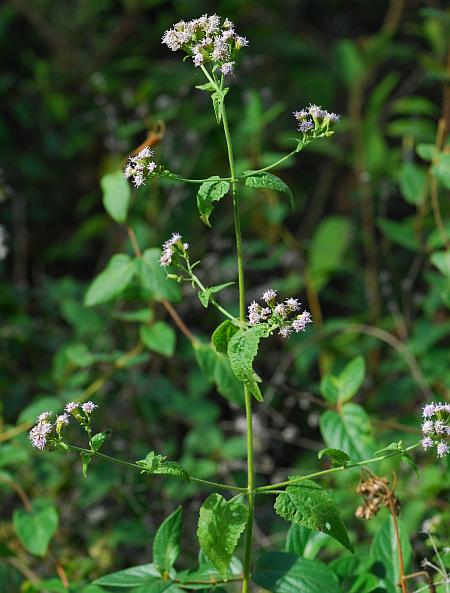Fleischmannia incarnata (Walter) R.M. King & H. Rob.
Pink Thoroughwort

Native
CC = 9
CW = 0
MOC = 13
© SRTurner
Fleischmannia incarnata (Walter) R.M. King & H. Rob.Pink Thoroughwort | |
 |
Native CC = 9 CW = 0 MOC = 13 |
© SRTurner |
|
Family - Asteraceae/Eupatorieae Habit - Fibrous-rooted perennial forb. Stem - Loosely ascending, sometimes reclining on other vegetation, to 1.2 m, sometimes multiple from a spreading base, branched, pubescent with short, curly hairs.
Leaves - Opposite at widely spaced nodes, simple, sessile or petiolate. Blades 0.8-7.0 cm long, triangular-ovate to heart-shaped, the uppermost sometimes only triangular-lanceolate, usually cordate at the base (the uppermost leaves sometimes broadly angled), tapered to a usually sharply pointed tip, the margins shallowly scalloped or bluntly toothed, the upper surface glabrous or minutely hairy, sometimes only along the veins, the undersurface moderately to densely hairy, especially along the veins, usually not glandular, with mostly 3 main veins.
Inflorescence - Flat-topped panicles of flowering heads at branch tips.
Heads - Discoid with 13-25 florets, often subtended by 1 or a few narrow bracts. Involucres cylindrical or narrowly bell-shaped, 3-5 mm long, with 18-30 bracts in 2-3 subequal overlapping series, these narrowly oblong-elliptic to narrowly lanceolate, tapered to a bluntly or more commonly sharply pointed tip, all but the outermost noticeably but finely few-nerved or few-ribbed, glabrous or sparsely short-hairy. Receptacle flat or slightly convex.
Flowers - Ray florets absent. Disk florets with the corollas pale pink to purple. Pappus of numerous capillary bristles.
Fruits - Achenes 1.8-2.5 mm, finely 5-ribbed, slightly wedge-shaped in profile, glabrous, the ribs smooth or with a few minute, ascending teeth, lighter colored, the body otherwise dark brown to black. Flowering - August - October. Habitat - Swamps, bottomland forests, bases of bluffs, streambanks, ditches, railroads, roadsides. Origin - Native to North America. Lookalikes - Some resemblance to species of Eupatorium, Ageratum, and Conoclinium. Vegetatively resembles Nepeta cataria. Other info. - This is an uncommon species in Missouri. In appearance it is reminiscent of a gangly ageratum with pinkish florets and catnip-like leaves. The plant is indeed most closely related to ageratums such as Conoclinium coelestinum. It is found in the far southern regions of the state, primarily in the Mississippi Lowlands division. Beyond Missouri it occurs in scattered locations across the southeastern continental U.S. Photographs taken at Holly Ridge Conservation Area, Stoddard County, MO, 10-5-2011, and at General Watkins Conservation Area, Scott County, MO, 10-4-2017 (SRTurner). |